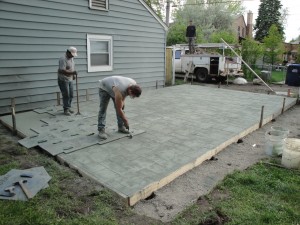BLOG
A Concrete Calculator Isn’t the Only Way
by TRP Ready Mix on August 6, 2016
 When starting any project, the amount of ready mixed concrete you’re using is extremely important. Depending on the size of your job, ordering the wrong amount of concrete can be incredibly detrimental. Order too much concrete and you’ll incur costs that you normally wouldn’t have budgeted for. You’ll also have to go through the hassle of disposing of all this excess concrete in an environmentally suitable way. Order too little concrete and you likely won’t have enough to finish the job. This could incur you even greater costs because you’ll likely have to pay overtime to your staff and purchase additional materials to have your job completed. You also might end up with a cold joint. A cold joint is where one pour was ended and another pour began. This can happen if you have to start and stop a job more than once.
When starting any project, the amount of ready mixed concrete you’re using is extremely important. Depending on the size of your job, ordering the wrong amount of concrete can be incredibly detrimental. Order too much concrete and you’ll incur costs that you normally wouldn’t have budgeted for. You’ll also have to go through the hassle of disposing of all this excess concrete in an environmentally suitable way. Order too little concrete and you likely won’t have enough to finish the job. This could incur you even greater costs because you’ll likely have to pay overtime to your staff and purchase additional materials to have your job completed. You also might end up with a cold joint. A cold joint is where one pour was ended and another pour began. This can happen if you have to start and stop a job more than once.
It is for reasons like this that most people use a concrete calculator to determine how much ready mixed concrete is required for a job. Most companies have a concrete calculator on their website and for good reason: it determines the exact volume of concrete needed by basing it on the depth, length and width measurements of your project. A concrete calculator is the most common method of determining how much concrete is needed for a project. However it’s not the only way to determine how much is needed. Instead of a concrete calculator, below are some tips for calculating the amount of ready mixed concrete needed for different types of projects:
Slabs
- Usually add about ¼” to the thickness of your concrete slab. This practice makes the assumption that your concrete is well compacted and is equally graded.
- If your grade is thicker in one spot than in another, the best option is to fix the grade because it’s better for your budget and the quality of the job.
- Make odd shapes into rectangles or squares. This makes them much easier to measure and means you won’t need a concrete calculator.
Footings
- Footings are pretty tricky. They’ll rarely follow any drawings as exactly as you’d want.
- Get an average size by checking a bunch of different spots, as opposed to just one.
A concrete calculator is a great tool to use when dealing with ready mixed concrete, but it’s definitely not the only method at your disposal. Just make sure all your measurements are double- and even triple-checked.
